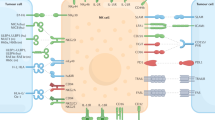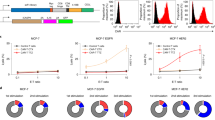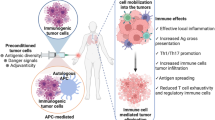Abstract
Two approaches to the antibody-directed targeting of toxic or cytolytic activity and augmentation of cellular immune responses have been explored for tumour immunotherapy, but so far success has been limited1–3. Obstacles facing immunotherapy are the limited accessibility of antibodies or antibody conjugates to solid tumours and the difficulty in obtaining tumour-specific cytotoxic lymphocytes4–7. Here we generate a new class of tumour-specific killer cells by genetically modifying lymphocytes to produce and secrete a targeted toxin against an oncoprotein overexpressed on breast and other tumour cells. The transduced lymphocytes were shown to have potent and selective cytotoxicity to tumours in culture and nude mouse models. The potent in vivo antitumour activity is probably a result of the migration of the lymphocytes to tumours as a targeted toxin carrier, and production and accumulation of the targeted toxins inside tumours as a producer. Our approach, which has features of both antibody-directed and cell-mediated immunotherapy, may have application in a gene therapy context.
This is a preview of subscription content, access via your institution
Access options
Subscribe to this journal
Receive 51 print issues and online access
$199.00 per year
only $3.90 per issue
Buy this article
- Purchase on Springer Link
- Instant access to full article PDF
Prices may be subject to local taxes which are calculated during checkout
Similar content being viewed by others
References
Vitetta, E. S., Fulton, R. J., May, R. D., Till, M. & Uhr, J. W. Science 238, 1098–1104 (1987).
Pastan, I. & FitzGerald, D. Science 254, 1173–1177 (1991).
Rosenberg, S. A. et al. N. Engl. J. Med. 319, 1676–1680 (1988).
Jain, R. K. Sci. Am. 271, 58–65 (1994).
Shockley, T. R. et al. Cancer Res. 52, 357–366 (1992).
Perez, P., Hoffman, R. W., Shaw, S., Bluestone, J. A. & Segal, D. M. Nature 316, 354–356 (1985).
Gross, G., Waks, T. & Eshhar, Z. Proc. Natl Acad. Sci. USA 86, 10024–10028 (1989).
Hwang, J., Fitzgerald, D. J., Adhya, S. & Pastan, I. Cell 48, 129–136 (1987).
Walter, P. & Lingappa, V. R. Annu. Rev. Cell Biol. 2, 499–516 (1986).
Kasprzyk, P. G., Song, S. U., DiFiore, P. P. & King, C. R. Cancer Res. 52, 2771–2776 (1992).
Batra, J. K., Kasprzyk, P. G., Bird, R. E., Pasten, I. & King, C. R. Proc. Natl Acad. Sci. USA 89, 5867–5871 (1992).
Chen, S.-Y., Khouri, Y., Bagley, J. & Marasco, W. A. Proc. Natl Acad. Sci. USA 91, 5932–5936 (1994).
Potter, C. R. D. et al. Histopathol. 15, 351–362 (1989).
Press, M. F., Cordon-Cardo, C. & Slamon, D. J. Oncogene 5, 953–962 (1990).
King, C. R., Fischer, P. H., Rando, R. F. & Pastan, I. Sem. Cancer Biol. 7, 79–86 (1996).
Slamon, D. J. et al. Science 244, 707–712 (1989).
Di Fio, P. P. et al. Science 237, 178–182 (1987).
Kraus, M. H. et al. EMBO J. 6, 605–610 (1987).
Culver, K. et al. Proc. Natl Acad. Sci. USA 88, 3155–3159 (1991).
Miller, A. D., Trauber, D. R. & Buttimore, C. Somat. Cell Mol. Genet. 12, 175–183 (1986).
Yang, A. & Chen, S.-Y. Nature Biotechnol. (in the press).
Marasco, W. A., Haseltine, W. A. & Chen, S.-Y. Proc. Natl Acad. Sci. USA 90, 7889–7893 (1993).
Collier, R. J. & Kandel, J. J. Biol. Chem. 246, 1496–1503 (1971).
Chen, S.-Y., Zani, C., Khouri, Y. & Marasco, W. A. Gene Thera. 2, 116–123 (1995).
Osborne, C. K., Hobbs, K. & Clark, G. M. Cancer Res. 45, 584–590 (1985).
Johnson, R. A. & Prentice-Hall, W. D. W. (eds) Applied Multivariate Statistical Analysis 226–290 (Englewood Cliffs, NJ, 1982).
Miller, A. D. Curr. Top. Microbiol. Immunol. 158, 1–24 (1992).
Author information
Authors and Affiliations
Rights and permissions
About this article
Cite this article
Chen, SY., Yang, AG., Chen, JD. et al. Potent antitumour activity of a new class of tumour-specific killer cells. Nature 385, 78–80 (1997). https://doi.org/10.1038/385078a0
Received:
Accepted:
Issue Date:
DOI: https://doi.org/10.1038/385078a0
This article is cited by
-
Primary T cells for mRNA-mediated immunotoxin delivery
Gene Therapy (2018)
-
Enhancement of the cytotoxic activity of cytokine-induced killer cells transfected with IL3PE38KDEL gene against acute myeloid leukemia cells
Annals of Hematology (2014)
-
Multi-Compartmental Vaccine Delivery System for Enhanced Immune Response to gp100 Peptide Antigen in Melanoma Immunotherapy
Pharmaceutical Research (2012)
-
Defective Protein Folding and Aggregation as the Basis of Neurodegenerative Diseases: The Darker Aspect of Proteins
Cell Biochemistry and Biophysics (2011)
-
Human mesenchymal stem cells-like cells as cellular vehicles for delivery of immunotoxin in vitro
Biotechnology Letters (2009)
Comments
By submitting a comment you agree to abide by our Terms and Community Guidelines. If you find something abusive or that does not comply with our terms or guidelines please flag it as inappropriate.



